A Very Abbreviated History of the Navajo
The Navajo tribe and their traditions have been shaped by proximity, adversity and opportunity.
According to anthropologists and tradition, the Navajo, a nomadic tribe, were the last Indian tribe to settle in the American Southwest, arriving two to three centuries before the Spanish. They lived in harmony with their neighbors, the Pueblo Indians and the Anasazi, learned how to weave with cotton and grasses , planted crops and curtailed their nomadic ways–until the arrival of the Spanish in the 16th century. The Navajo retreated into the high desert and canyons and from these strongholds, began “liberating” the sheep and horses that the Spanish brought with them.
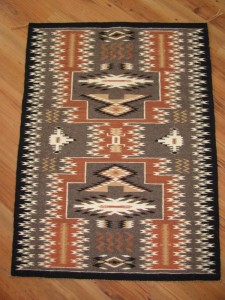
Storm Pattern by Marilyn Greaves
The churro sheep was the perfect breed for the high and dry American Southwest and provided the Navajo with wool for weaving and a steady source of protein for their health. The horses allowed the tribe to cover a larger area for foraging and raiding.
Then came the influx of the Americans: ranchers,miners and settlers who wanted to use the Navajo lands. This led to bloody confrontations, broken treaties and atrocities on both sides. The U.S. Government decided the “Navajo problem” had to be solved by a ‘scorched earth’ campaign in 1863. The U.S.Calvalry destroyed all things Navajo–their crops and homes. They killed the horses and sheep and finally destroyed the peach orchards in Canyon de Chelly, essentially starving the Navajo. Their only hope was to surrender.
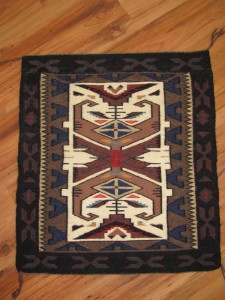
Teec NosPos by Marilyn Greaves
The U.S. Government forced the remnants of the tribe to relocate to Bosque Redondo, New Mexico. The relocation turned out to be an expensive failure and the Navajo were allowed to return to their land in 1869. However, the government had killed almost all their sheep and by 1900 almost eradicated the breed.
By the 1880’s, trading posts were established and they functioned as a buffer between the white man and the Indian. The West was opening up to long distance commerce. The Navajo wearing blanket had been sought after in the past for its tight weave and good design and had been traded with other tribes and the white man before the Navajo relocation. Now, as the Navajo began rebuilding their culture and their lives, several traders were influential in helping the Indians focus on designs that would sell well to the wealthy tourists and travelers who were discovering the Southwest by train and, later, by car.
Today there are many styles of Navajo rugs that use a great many vegetal and analine dyes to create beautiful palettes.Some of these include Pine Springs, Teec Nos Pos, Wide Ruins, Burntwater, Klagetoh, Ganado, Crystal and Storm, just to name a few. The Two Grey Hills rug design is an exception, using only wool colors obtained from naturally colored fleeces.
Many of these weavings are said to have design elements that are representative of myths and cultural beliefs of the Navajo. Cartoons or graph paper drawings are not used. Designs are repeated in a family of weavers so many times that they become automatic. They are simply adjusted to fit into the warp dimensions of the weaver’s present rug project.
Some of the modern Navajo weavers who depend on their weaving for income may break out of the family’s traditional patterns and weave varying designs, for the most part, dictated by what might be more in demand or sell more quickly. Other younger weavers have become very artistic in their creations as well and weave modern, untraditional patterns which can be quite interesting and attractive. The beauty is in the eye of the beholder, and you can never go wrong no matter what style or pattern you may choose to weave or purchase.
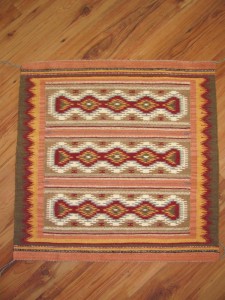
Pine Springs by Marilyn Greaves
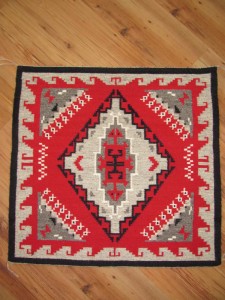
Ganado weaving by Marilyn Greaves
MARILYN’S STORY
I am not a Navajo weaver, but a weaver in the Navajo tradition. This is the creed by which I weave. My introduction to fiber arts truly came in the early 1990s. I had always been a hobbyist dabbling in crafts, mostly in the area of sewing, stained glass, wood working and a little bit of knitting and crocheting over the years. I never felt like any of these categories were my true calling and never stayed with any of them for long. They were just simple pastimes. I had always had a love of earthy things with texture and substance. Then, in 1991, my family and I took a long camping vacation to the Southwest and I realized at that time how much I loved the arts and crafts of that area, primarily pottery, basketry and the weaving.
Around that same time, I became acquainted with Mel Silva. Coincidentally, Mel had also taken a trip to the Southwest the same year. Having had some prior experience with Navajo weaving, Mel wanted to learn more and asked if I would be interested in that endeavor as well. That was the beginning or our Navajo weaving “careers” and after having a wonderful introduction to the craft by Caroline Spurgeon, we then studied with other master weavers on the Reservation including Sarah Natani, of Shiprock, NM, and Angie Maloney, of Tuba City, AZ. These experiences provided us with much, much more than weaving instruction. We spent time on the Reservation and were immersed into their culture and family activities as well.
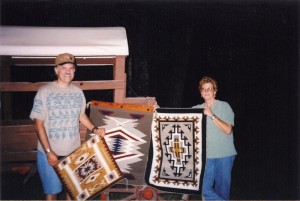
Mel and Marilyn with some of their weavings
Today I continue to weave on a regular basis. I have many looms of varying sizes and rarely go anywhere without one in tow. I always have at least three or four projects going at any one time. Whatever loom I decide to take along on my travels goes into the vehicle first and the rest of the contents have to fit around it. I have a wall of hanging skeins of wool and another wall of cubicles filled with rolled balls of varying colors and hues. The Navajo believe that if you have wool to spin and yarn to weave you will not die until it is all used.
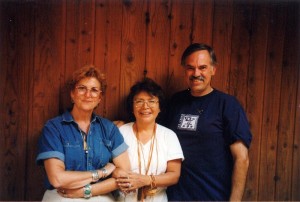
Marilyn and Mel with Navajo weaver Angie Maloney in Carbondale, CO
Along with Mel Silva, I teach several workshops a year in an ongoing effort to perpetuate the craft. This is very gratifying to me. There is a fear that this art form may die out as the young people on the Reservation are not continuing to learn from their elders and to weave in any significant numbers. Therefore, as instructors, we feel that we are passing on the craft as a little bit of insurance that this may not happen. Some of the Navajo do not approve of the Anglos weaving, but we have been fortunate enough to have contact with those who do appreciate what we are doing. We do not sell our work, only our knowledge, so we do not feel we are infringing on the cultural values of the Navajo. In addition, there are only a couple of teachers of traditional Navajo weaving in California and many who might be interested in learning are not able to travel to the Reservations and camp out as we have in order to learn.
No matter what else I may become, I will always be a weaver!
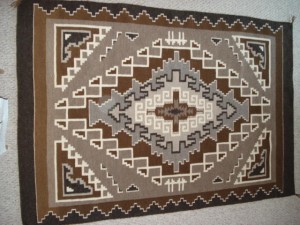
Two Grey Hills rug by Marilyn Greaves
MEL’S STORY
As a young boy I was interested in the Native American people, their arts and crafts. I remember a motoring trip with my parents across the Navajo Nation which included Monument Valley and I was so impressed with their culture and sacred homeland. In the early 1980’s I discovered traditional Navajo weaving from Working With The Wool by Noël Bennett and Tiana Bighorse. My first rug making experience was sobering since it was evident that weaving even a small Navajo rug was a very lengthy process calling for a great deal of skill, time, and perseverance.
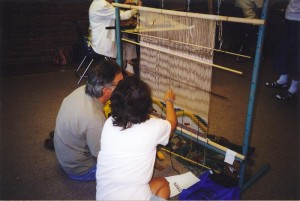
Mel with Navajo weaver Angie Malony in Tuba City , AZ
In the early 1990’s, working with many teachers in my profession, I discovered Caroline Spurgeon, an Anglo weaver. She agreed to expand my previous learning and take on a novice weaver friend as well, Marilyn Greaves. We both greatly enjoyed the time spent with Caroline who gave of her knowledge so that two weavers could grow in their skill weaving the Navajo Way. From that experience I have worked with Sarah Natani at her home in Shiprock, NM. I also had the extreme pleasure of spending three summers in Carbondale, Colorado, working with Angie Maloney, master weaver from Tuba City, AZ, and her sister Mae Peshlakai, a weaver of Navajo textiles and a silversmith.
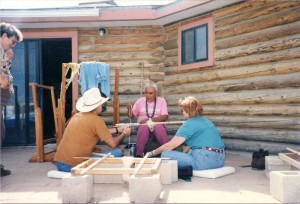
Mel and Marilyn getting instuction from Navajo Weaver Sarah Natani of Table Mesa, NM
Through Angie’s efforts I was immersed in weaving in the authentic Navajo way, and became one of her honorary clan, Ta’neeszahnii, the Tangle People.
Subsequently, along with my co-teacher Marilyn Greaves, we have taught traditional Navajo weaving in classes during the 1990’s to the present day in the Sacramento and Central Sierra foothill areas. Classes are offered at the Beginning, Intermediate, and Advanced levels. We are listed as an indigenous weaving instruction source on Mary Walker’s Weaving in Beauty web site, www.weavinginbeauty.com offering classes in the Sacramento area of CA.

Two Grey Hills weaving by Mel Silva
.
Navajo weaving is a labor-intensive and time-consuming endeavor. This craft is not one of instant gratification and many consider it too tedious for their liking. This is what makes us all different. For us, it is not about the production, but about the process. There is so much history connected with weaving in the Navajo style that usually while weaving we are thinking about the people and the culture from whence this wonderful craft came and for which we are privileged to have learned to weave. It is most rewarding to see the amazement on the faces of onlookers when they realize what a great amount of time and energy goes into the creation of a Navajo rug.
We both spin a bit and have done some fiber dying. We take the time to make our own twining cords for the ends and/or sides of a rug. Mel is accomplished on the Navajo spindle and has, on several occasions, hand-spun the wool for his project. The hand-spun yarn from a Navajo spindle does truly add a special and unique appearance to the finished product that is difficult to achieve with a commercial yarn.
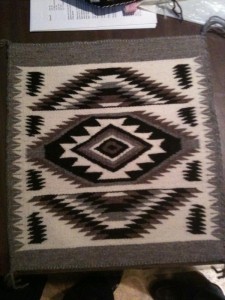
Mel's handspun rug

close up
For others, their primary interest is weaving and they may prefer to spend what precious spare time is available devoted to working at the loom. We try to purchase yarns as much as possible from Reservation sources and we have a dying expert in our Navajo weaving circle who can create wonderful custom colors and hues for us.
There is a picture of one of Marilyn’s unfinished large rugs in progress in the Navajo Looms article. Roughly calculated, it will have taken approximately 300 hours to weave when completed. Were Marilyn to have sheared a sheep, skirted the fleece, scoured, carded and spun the wool, the time for the entire project could probably easily double.
This craft has opened our world to many wonderful textures, colors, styles and techniques, and it has brought us together with a great many interesting and artistic people that we would be sad to have missed out on had we not ventured there.
In addition, I weave many traditional rug styles, twills, tufted, pictorial, including an authentic Navajo horse cinch. I have been making Navajo vertical style looms, full size and mini. I also have fashioned weaving tools, forks, battens, etc. from exotic and traditional woods since the early 1980s. I am a member of the Ashtl’o Weaving Guild, the Sacramento Spinners and Weavers Guild, The Hangtown Fiber Guild, and the Great Basin Basket Makers Guild, located in Reno, NV.
For more about Navajo looms and weaving tools , click here.